You used to watch ads. Now, you skip them. You used to tolerate interruption. Now, you pay for peace. And so, brands have had no choice but to evolve.
Brand building has shifted entirely. Traditional ads, once the primary vehicle for awareness and conversion, are losing their grip in a culture that prizes control, entertainment, and authenticity. Banner blindness, ad blockers, and streaming platforms have made it clear: people don’t want to be sold to. They want to be entertained, engaged, and emotionally invested.
This is the death of the ad—and the rise of the show.
Instead of buying attention, brands are learning how to earn it. They’re moving away from 30-second spots to episodic content, from product pitches to plotlines. Companies are no longer marketing to specific audiences—they’re building them. Brands are acting more like media companies, creator collectives, or mini-Hollywood studios, producing content that resonates not just for what it sells, but for how it makes people feel.
Why? Because attention is the most valuable currency in today’s economy. Competition is no longer direct competitors—it’s now Netflix, TikTok, MrBeast, and the dreaded, endless doom scroll.
In this new era of brand building, those who entertain will win. The rest? They fade into the skip button.
Why Traditional Ads Are Losing Power
Brand marketing hasn’t changed overnight, but the shift is undeniable. Traditional advertising, once the backbone of brand visibility and growth, is now struggling to stay relevant in a culture defined by choice, speed, and skepticism. Here’s why:
- Ad Avoidance Is The Norm: People are tired of ads. With the widespread use of ad blockers and growing banner blindness, people are automatically tuning out anything that even remotely looks like a sales pitch. Trust in brands is low, and modern consumers, specifically GenZ, are fluent in spotting inauthentic marketing. They won’t put up with it.
- On-Demand Media Has Replaced Linear Viewing: People no longer sit through commercials. They stream, skip, and scroll. Platforms like TikTok, YouTube, and Netflix dominate attention spans, and ad-free subscriptions continue to rise. The days of buying prime-time attention are over.
- Audiences Crave Engagement, Not Interruption: The best content today is creator-led, interactive, and embedded in community. Passive consumption is out, active community connection is in. Brands that still rely on static ads are being outperformed by those who co-create, entertain, and embed into culture.
The bottom line? Traditional ads are built for reach. But today’s marketing requires resonance. And that means meeting audiences where they are, and engaging with them how they want to be engaged with.
What Is Branded Entertainment?
Since the dawn of time, humans have used stories to share knowledge, shape culture, and connect emotionally. From cave paintings to streaming series, storytelling has always been how we make meaning of life.
Branded entertainment taps into this timeless tradition, placing brands in the narrative before the marketplace. It’s a fusion that doesn’t disrupt. Brands that craft content or experiences that subtly inject their values, product, or mission into mediums that people search to watch, play, read, or listen to.
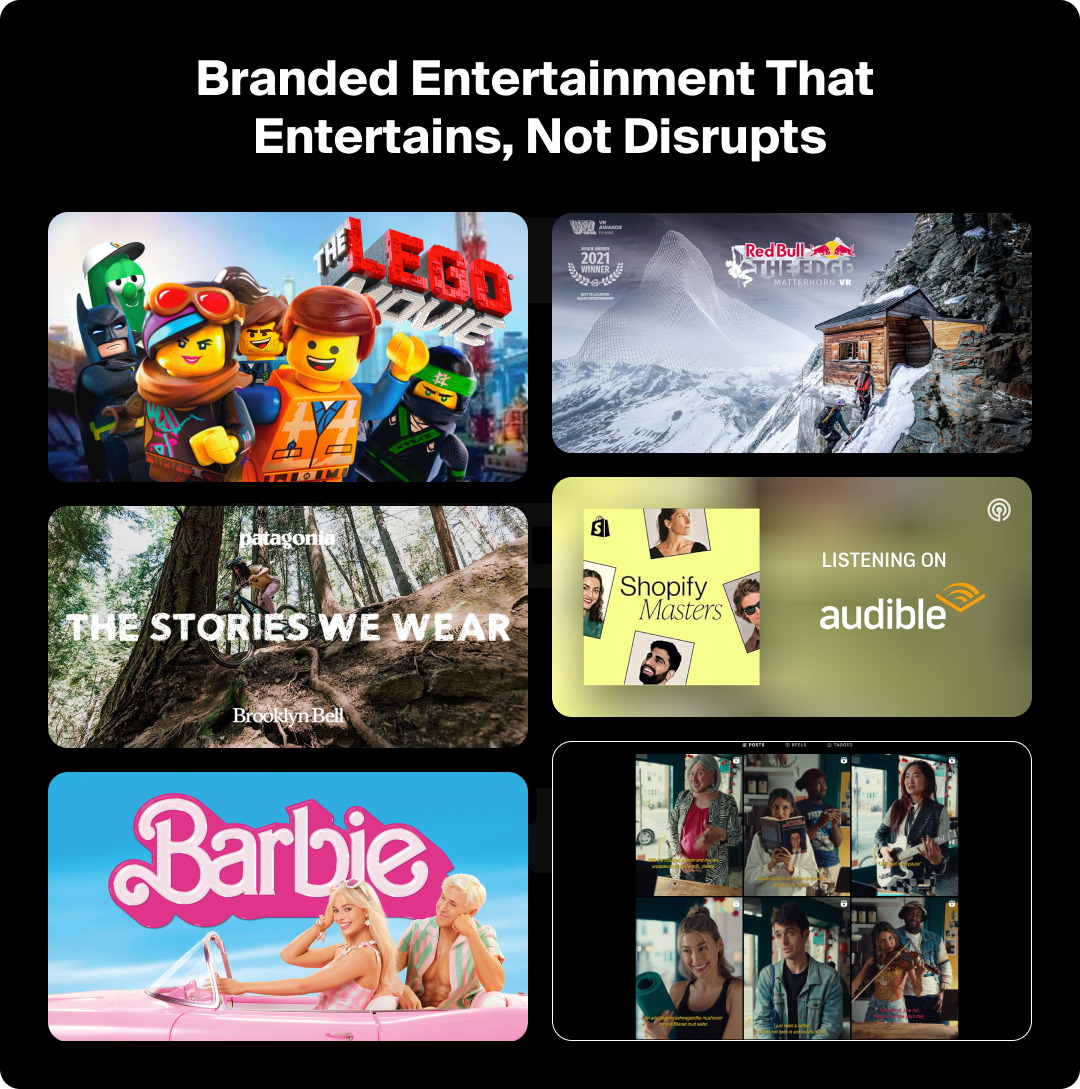
The most successful branded entertainment cases don’t feel like marketing—in fact, you might not even realize a large brand is behind the production. This type of branded content appears in all kinds of formats, whether it’s full-length films like The LEGO Movie, emotionally charged documentaries like Red Bull’s The Edge, or value-packed podcasts from Shopify, Deloitte, or BlackRock. Even social-first series like the Brooklyn Coffee Shop on Instagram prove that brands can build real audience connections through short-form content that people will spend time with. The goal is to entertain first and earn attention by building relevance, not promotion.
From selling to storytelling, this shift has given rise to different flavors of entertainment from brands. Depending on the audience and intent, brands aim to either entertain while informing, or educate while engaging. Let’s break down a few terms that you may have heard tossed around:
- Branded Content is any kind of content (video, podcast, substack, comic, or anything in between) that a brand creates to connect with an audience. It’s not about slapping a logo on something—the brand is part of the story itself, often woven in naturally as a key player behind the scenes.
- Infotainment mixes information with entertainment. Picture a mini-doc or a fun explainer series that pulls you in with a good story while teaching you something along the way.
- Edutainment takes this a step further—think more purpose-driven or educational. This is common in wellness, lifestyle, or B2B spaces where the brand acts more like a coach or expert, offering real insights while still keeping things engaging.
Formats Where Branded Entertainment Comes To Life
Similar to social media content, brands creating content crossing over from advertising to entertaining methodology isn’t confined to one medium. The strength of this marketing tactic lies in the ability to be flexible. Meet audiences where they already are, in formats they are familiar with and love. This can take the form of:
- Podcasts: An intimate, trust-building format, perfect for brands that want to share detailed insights, values, or human stories over time. Shopify’s entrepreneurial stories and Gatorade’s athlete interviews offer inspiration and alignment with the brand purpose, without feeling like a sales pitch to invest in the product or service.
- Mini-Series & Films: Long-form narratives give brands space to go deep, emotionally, culturally and creatively. Just look at the aftermath of Barbie and The LEGO Movie. Not only are they ads in disguise, they are full-blown cinematic universes that reinforce brand identity while captivating mainstream audiences.
- Social-First Shows: On platforms like TikTok, YouTube Shorts and Instagram Reels, episodic storytelling is allowing brands to engage in fast, culture-savvy ways. These formats are easily accessible to people commuting and going about their normal lives. Brands that nail this medium perform best when they create content that feels native to each feed: lightweight, relatable and easy to follow. A great example is the Brooklyn Coffee Shop series on Instagram, where a fictional café becomes a stage for humorous, low-lift, high-engagement content that subtly showcases products while building a loyal fanbase.
- Webtoons & Comics: For brands with rich story worlds or character-led narratives, visual storytelling formats like webtoons can build cult-like fandoms over time. Think of these mediums as a slow-burn, with high rewatch and reshare potential.
- Docu-Style Storytelling: Real stories, real people, and real impact. Patagonia’s environmental series and RedBull’s The Edge documentaries tap into lived experiences and value-driven missions that align with each brand. They create an emotional resonance that feels more like journalism than marketing.
- Games & Interactive Content: Gamified content is on the rise across social media platforms like TikTok. They build immersive experiences orchestrated by the brand as a world users are welcomed into. For example, LEGO’s entire game ecosystem lets the audience build, explore, and imagine—all while staying rooted in the brand’s DNA.
Key Characteristics: What Makes It Work
No matter the format, branded entertainment is most effective when it follows a few core principles:
- Story-Driven at Heart: The narrative comes first—the brand doesn’t lead the story, it lives within it.
- Subtle, Seamless Product Integration: Products or services may appear, but they serve the story, not the other way around. The goal is resonance, not a hard sell.
- Values Over Visuals: Reflect what the brand stands for, not what it sells. It builds affinity through alignment with audience values like curiosity, creativity, wellness, sustainability, or empowerment.
When done right, branded entertainment blurs the line between marketing and media, creating content that people don’t just tolerate, but actively choose or search to spend time with.
Brands Doing It Right
Social Shows

1. GANT’s New York Stories
GANT’s New York Stories isn’t just a subtle advertising campaign camouflaged as social media content. It’s a cinematic love letter to old money Manhattan and the golden age of American prep. Through a three-part narrative, “The Pseudo Prep,” “The Blazer Bandit,” and “The Procrastinator”, GANT crafts a short, cinematic journey that captures the essence of New York City’s timeless elegance. Each chapter weaves together elements of classic American sportswear with a modern twist, showcasing the brand’s ability to tell compelling stories through fashion.
GANT embodies their European roots and American prep legacy through cinematic storytelling that feels more like art than advertising. By focusing on a storyline that highlights the brand’s roots in Ivy League style and East Coast prep, the brand is able to position itself uniquely in the market. Rather than operating from a mindset of selling clothes, GANT sells a lifestyle, one that glorifies luxury and refined aesthetic of old-money New York.
This approach connects audiences to the brand on a deeper level, offering a narrative that resonates with those who appreciate the nuances of style and tradition. By prioritizing storytelling over direct promotion, GANT effectively reinforces its brand identity and appeals to consumers seeking authenticity and elegance in their wardrobe choices.
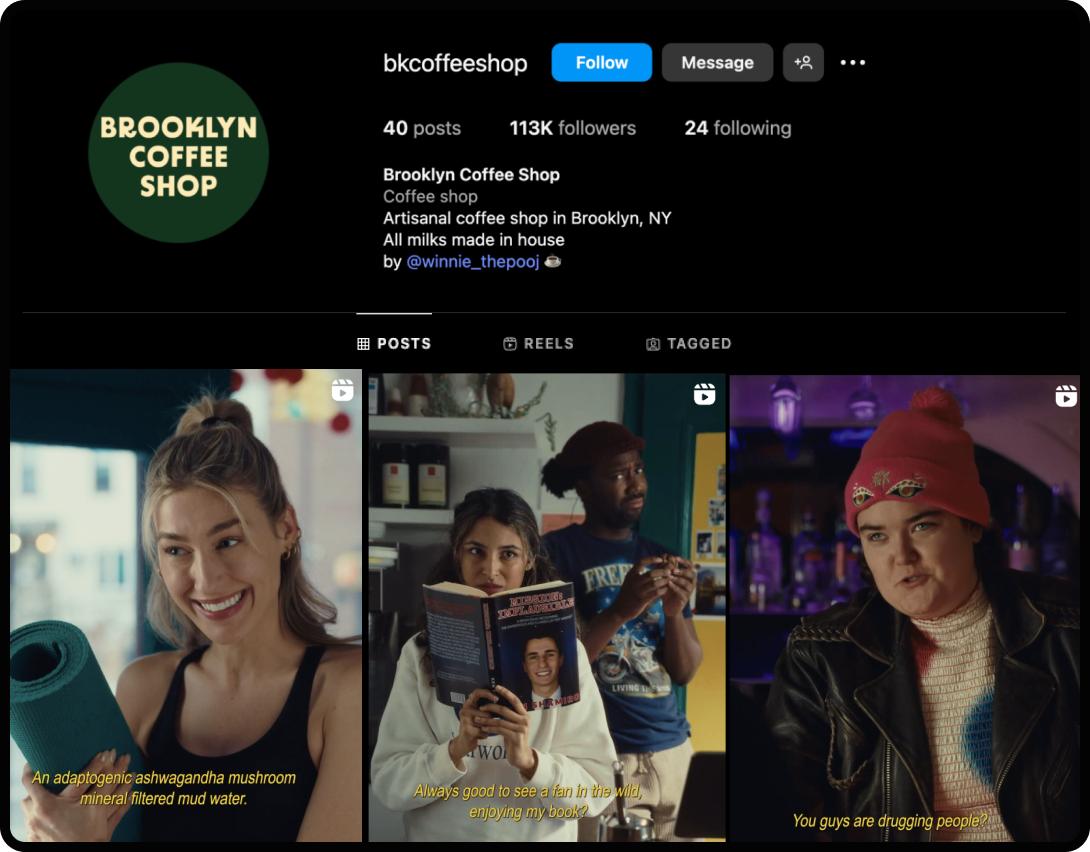
2. Brooklyn Coffee Shop
The fictional Brooklyn Coffee Shop series is a brand winning entertainment-led content. It’s so believable, many viewers thought the café actually existed. Through its Instagram episodes, the series turns everyday coffee shop chaos into hilarious, relatable moments that are made to be shared. By throwing audiences into awkward, ridiculous, and oddly comforting situations, it manages to spotlight coffee shop culture and products without ever feeling like an ad.
Another aspect that makes this brand’s content stand out is its use of consistent characters, quick-hit humor, and a fictional-yet-mainstream setting. It leans into the vibe of a real Brooklyn café, complete with quirky baristas and chaotic customers. All the while, it subtly integrates branded elements like drinks or merchandise into the background. It’s smart because it feels like something you’d stumble upon online—someone retelling a wild story or capturing a strange coffee shop interaction—not because it’s selling you something.
This series proves that you don’t need a massive production budget to pull off effective branded entertainment. When you create a world people want to return to and characters they grow fond of (in one way or another) audiences start building real connection and loyalty. It’s a masterclass in creating shareable, episodic content for the humor-hungry social viewer.
YouTube Long-Form Docuseries
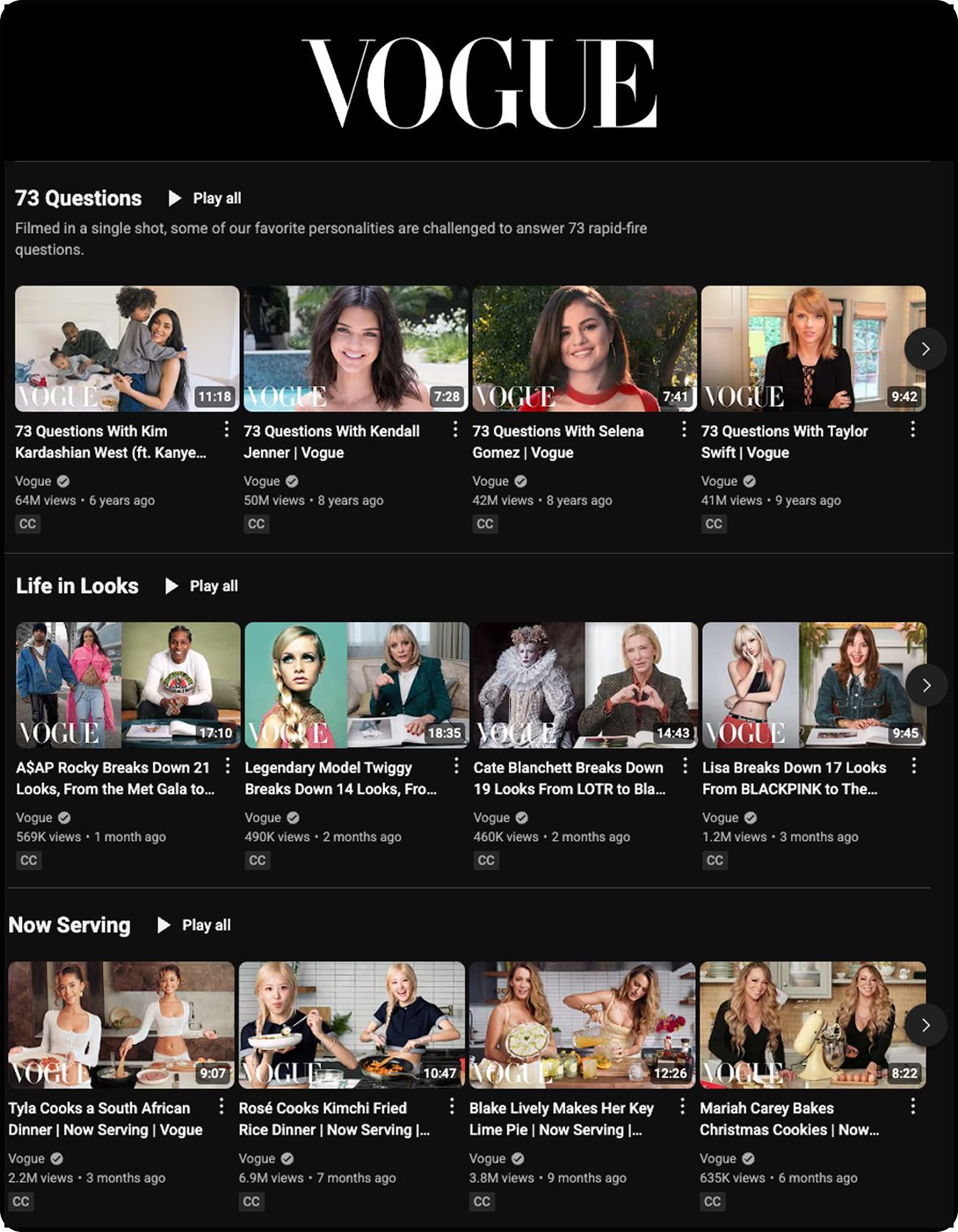
1. Vogue
Vogue has many YouTube entertainment series, my favorites being, 73 Questions, Life in Looks, and Now Serving. These serialized pieces of content have become a masterclass in evolving their legacy media brand into a modern cultural curator. These aren’t your basic celebrity interviews—they’re stylized glimpses into the lives, quirks, and histories of public figures, wrapped in formats that are bingeable and share-worthy.
Whether it’s a rapid-fire walk-and-talk through a celebrity’s home (73 Questions), a nostalgic tour through their fashion archives (Life in Looks), or a sit-down meal with an unexpected twist (Now Serving), each series strives to pull back the curtain on public figures.
Notably, 73 Questions launched back in 2014, well ahead of the curve. At a time when most brands were still focused on traditional ads or editorial, Vogue recognized the power of entertainment as a long-term content strategy. In doing so, they helped pave the way for a new wave of press diversification, blurring the lines between journalism, entertainment, and marketing. This early move set the stage for a broader cultural shift we now see with viral formats like First We Feast’s Hot Ones and Amelia Dimoldenberg’s Chicken Shop Date, where storytelling, humor, and creativity lead the conversation, not product placement or PR soundbites.
What makes this example stand out today is that Vogue uses their series to expand far beyond fashion. While style remains the core of their visual language, the material dives into identity, legacy and lifestyle. Celebrities open up about insecurities, personal milestones and creative processes. This multi-dimensional approach humanizes some of the most famous figures and reshapes Vogue’s brand from fashion authority to cultural storyteller.
With sleek production, staple visual tone and subtle editorial cues, the brand has been able to build trust and intrigue not by selling clothes or magazines but by letting audiences feel like insiders to the world behind the gloss.

2. Architectural Digest
Architectural Digest has quietly built one of the most engaging content ecosystems on YouTube with series like Open Door, Small Spaces, and The Blueprint. Each show gives a different lens into how people live, design, and express themselves through space, spanning everything from stepping inside the jaw-dropping homes of celebrities, learning how creatives make the most of 400 square feet, or breaking down iconic architecture in pop culture.
Open Door in particular has become a cultural fixture. It invites audiences into the homes of A-listers to understand the personalities behind its admirable interior design. These are elevated tours, showcased as storytelling through space. What AD does so well is transform traditional shelter media into entertainment-first content that feels aspirational and deeply human. Their success proves that lifestyle media can thrive in new formats when it prioritizes curiosity, visual richness, and the lived-in details that make each story memorable.
AD has tapped into a YouTube generation while maintaining its editorial authority. It’s a prime example of how a heritage brand can expand its influence by creating experiences people want to watch and share, not scroll past.
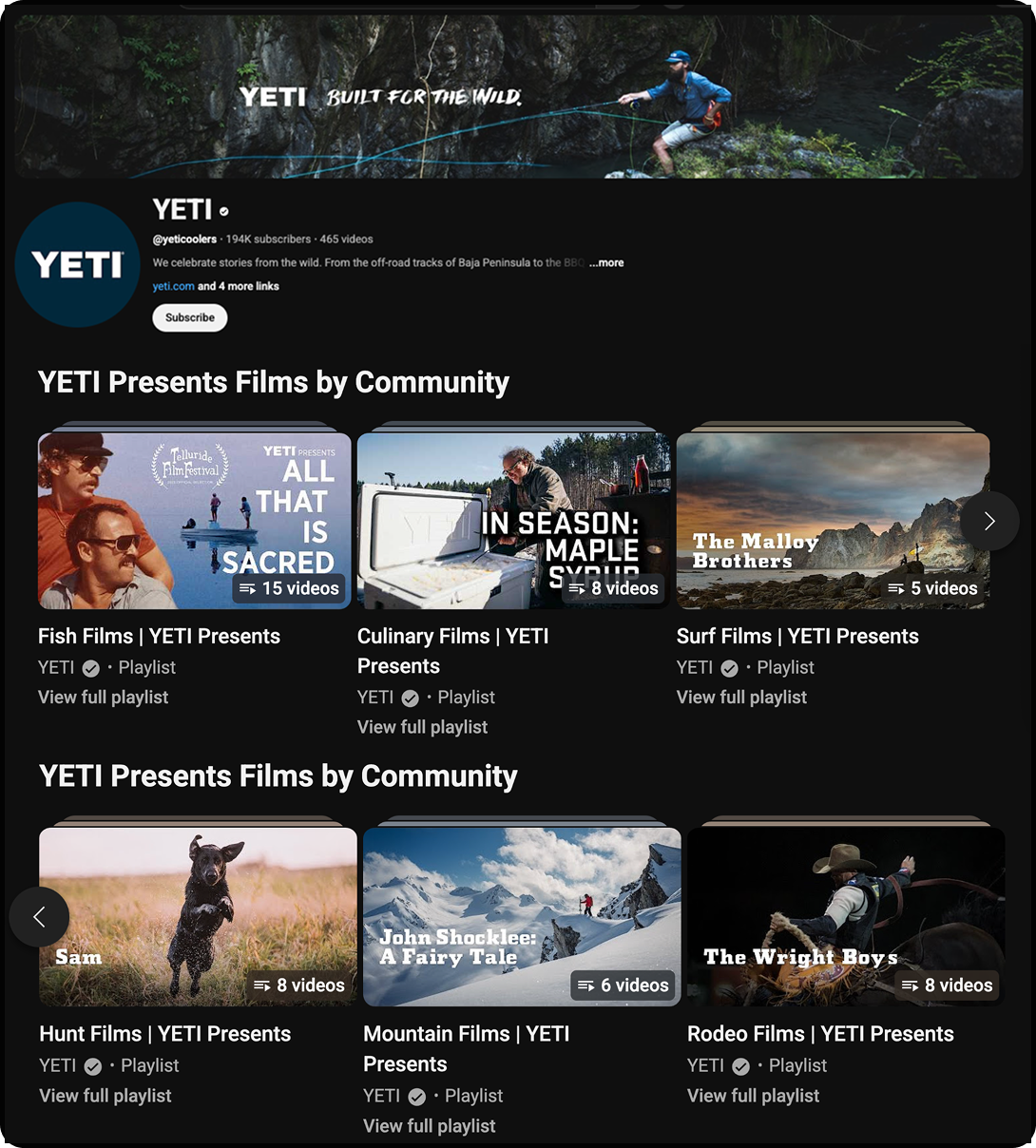
3. YETI
YETI has carved out a unique lane in branded entertainment by producing high-end, cinematic documentaries that celebrate the wild, the rugged, and the communities that thrive within it. These aren’t quick-hit social videos or scrappy vlog-style recaps, they’re polished, atmospheric, and deeply intentional. Each film feels like a love letter to a lifestyle, with sweeping visuals, raw emotion, and storytelling that could easily live on the festival circuit. It’s a bold move in a world obsessed with short-form, but it works because YETI knows exactly who it’s speaking to: people who don’t just admire adventure—they live it everyday.
The films are batched across subcultures within the brand’s broader community such as fly fishing, culinary craft, mountain sports, surfing, hunting, and rodeo life. Each story taps into a different pocket of the outdoor world, yet they all orbit around the same values that YETI embraces: endurance, respect for nature, and the pursuit of mastery.
Rather than pushing products, YETI positions itself as a cultural documentarian of the wild. The brand earns credibility by elevating its subjects and letting the content breathe, proving that with the right storytelling, a brand can create cinema, not just content.
Podcasts
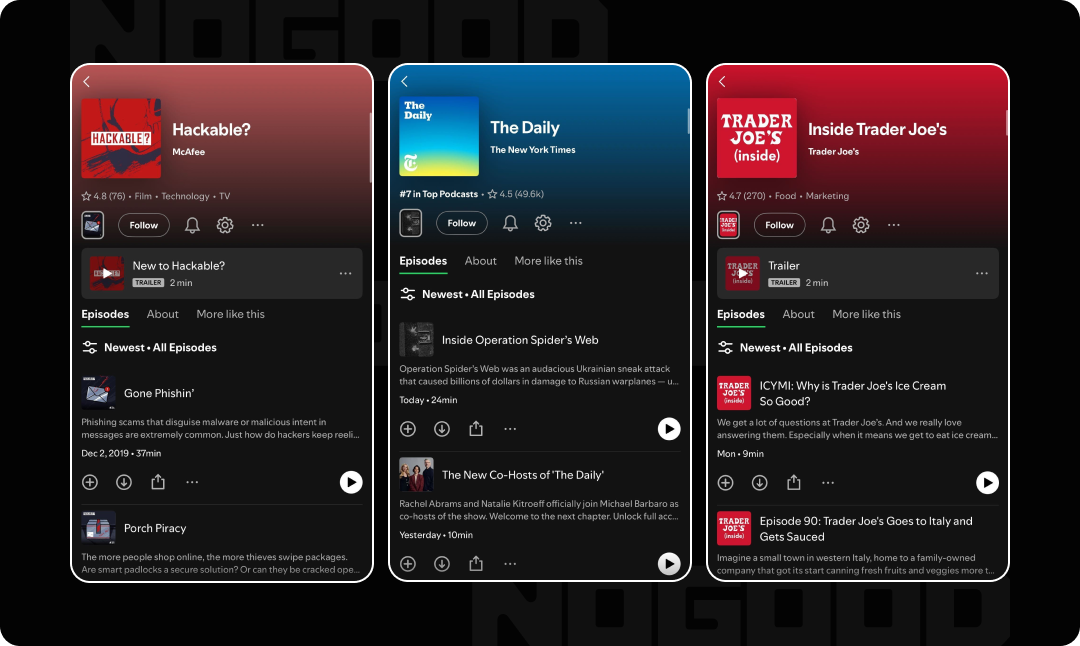
The podcast boom has become more than just another ad space. It’s a powerful storytelling tool. Brands are creating their own shows, using podcasts as an extension of their trust built with audiences, sharing their values in more detail and engaging deeper with their community.
- Hackable?
McAfee’s Hackable? podcast stands out in the tech space by demystifying cybersecurity, a topic that’s complex, intimidating and easy to tune out without the magic of audio listening. The show has achieved over 920,000 downloads across 10 episodes and boasts a 5-star rating on Apple Podcasts. Named “Best Branded Podcast” at the 10th Annual Shorty Awards.
Notably, 79% of listeners could identify McAfee as the sponsor, and 65% reported a higher opinion of the brand after listening, demonstrating the podcast’s effectiveness in brand building.
- The Daily
The Daily, launched in 2017, has become a cornerstone of modern news consumption, attracting millions of listeners daily. In 2024, it was the most popular show on Apple Podcasts, and by 2025, it continues to lead in the podcasting space. While this show is a product of The New York Times and primarily a journalistic endeavor, it provides a more modern and interactive way for audiences to engage with the brand.
By offering digestible, compelling content in an accessible format, it transforms traditional journalism into an entertaining experience.
- Inside Trader Joe’s
Inside Trader Joe’s podcast stands out as the dynamic intertwining of a grocery store brand and entertainment that is anything but expected. The shows’ authentic, behind-the-scenes approach to brand storytelling launched in 2018, well ahead of most retail brands entering podcasting. Listeners get a peek into the company’s culture, product decisions, and quirky charm through conversations with real employees.
Its approachable tone and transparency helped it quickly rise to No. 5 on the iTunes podcast charts. It’s a prime example of how relatability and genuine storytelling can turn a brand podcast into a loyal community-builder.
Strategic Shifts: How Brands Can Adapt
Branded entertainment is often heavily leaning on character development and culturally relevant stories. Characters like “Mayhem” and “Jake from State Farm” showcase how strong characters even in advertisements can create cultural relevance and lasting brand connections. True branded entertainment goes further: it places characters in standalone content like web series or podcasts, that audiences choose to watch, where the brand’s presence is subtle, not salesy. For brands to adapt, they need to move beyond interruptive ads and focus on creating immersive stories that people actively seek out and engage with.
To compete in the entertainment space, brands need to think (and hire) like content studios. That means bringing on writers, directors, and producers who understand storytelling, not just marketing. This internal strategic shift will build the foundation for branded content that resonates beyond a campaign cycle.
It also requires flipping the script: developing ideas from a community-first perspective rather than starting with a product. When content speaks to shared values or interests, the brand becomes part of a larger conversation, not the center of it.
Finally, platform-native thinking is essential. What works on TikTok won’t translate to YouTube, Instagram or podcasts. Brands must tailor format, tone, and pacing to each channel’s unique audience behavior. Once again, meeting people where they are, in the way they are eager to engage.
Measurement: Redefining Success in the Attention Economy
In the era of branded entertainment, traditional metrics like click-through rates (CTR) or impressions only scratch the surface. Today, success looks more like completion rates, average watch time, saves, shares, and cultural resonance. This signals that someone did more than just see your content—they chose to stay with it. In a world flooded with distractions, attention is the real currency, and earning it requires a shift in what we track and value.
Virality is tempting and leadership within your brand might be requesting it. It’s not (and should not) be the only measure of impact. A one-off viral hit might spike metrics, but it rarely builds long-term loyalty. What matters more is the blend of reach, resonance, and relevance. So when building out a branded entertainment strategy, look beyond the hype to measure how this kind of material builds connection and awareness over time.
Ultimately, the brands who’ve been in the entertainment marketing game for a long time are measuring for brand equity. Not campaign performance. Is your content truly shaping how your brand makes people feel? Is it deepening emotional connection, even if it doesn’t immediately drive a click? Branded entertainment plays the long game, like all smart strategies. Don’t silo your team into tracking how many people watch but, how many people care.
Challenges & Limitations
Marketing teams need to ask: What story are we uniquely positioned to tell—and why would anyone care? It’s not just about producing as much content as possible, it’s about building something that aligns with your brand’s DNA and delivers real (and extra) value to your audience. Entertainment without strategy is just noise.
Here are a few more challenges to consider:
- A beautifully shot film or viral skit means nothing if the audience can’t connect it back to your brand’s purpose or values.
- The budget is a reality check. Great storytelling doesn’t always need blockbuster money but it does require investment in talent, time, and craft. Without it, the content risks feeling flat or forgettable.
- There’s a fine line between subtle and invisible branding. If the brand is too loud, it feels like an ad and people will quickly try to tap out. Too quiet, and the audience forgets who made it. The sweet spot? Creating something worth watching because it’s from you—not in spite of it.
The Future of Brand Entertainment
As audience expectations evolve, so does the future of branded material and it’s becoming more interactive, intelligent, and community-powered than ever before.
Artificial Intelligence has opened the door to faster content creation and hyper-personalized narratives. From dynamic scripts to generative visuals, brands will soon be able to tailor entertainment at scale, producing stories that adapt to viewer behavior or even let the audience shape the plot. Think interactive series, playable brand moments, or storylines that evolve based on community input.
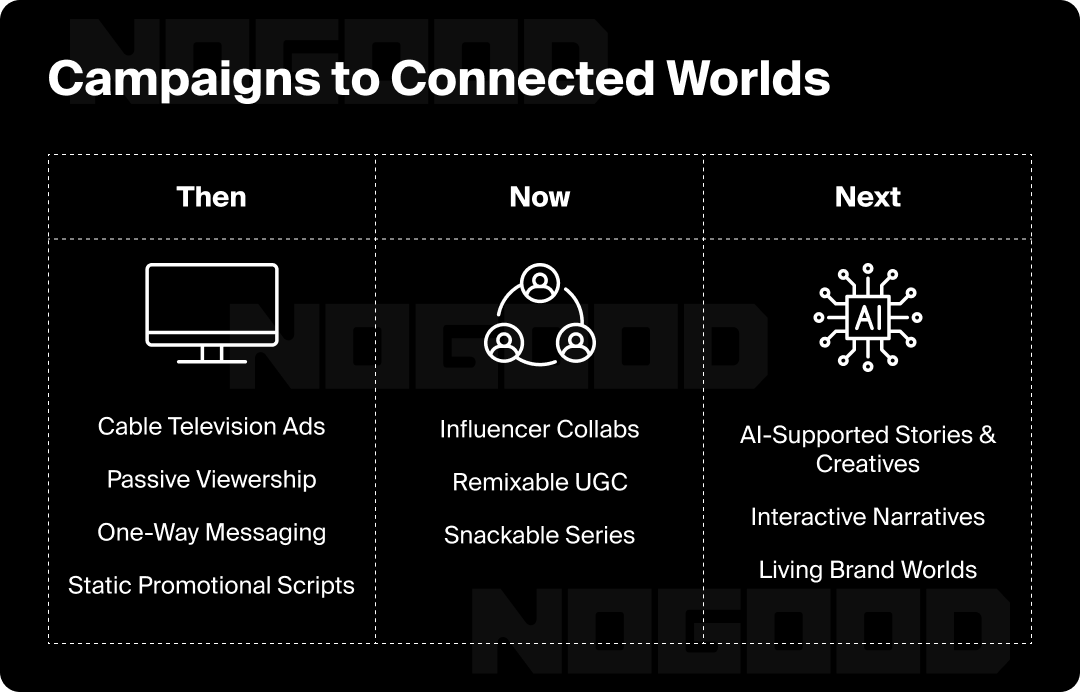
User-generated content and influencer co-creation are also pushing brands to become collaborators, not just creators. Future-forward brands will build with their audience, not talk at them. We’re already seeing this with fans remixing brand content on TikTok or influencers anchoring branded social shows. The smartest brands are leaning in, not fighting it.
Most importantly, we’ll see a shift from one-off campaigns to IP-building. Instead of reinventing the wheel every quarter, brands will invest in worlds, characters, and formats that can live across platforms and evolve over time. Think Barbie, not banner ads.
The Brand as the Showrunner
Most brands are still playing it safe. They’re still focused on running ads, chasing trends, and optimizing for clicks. But the brands that are breaking through, across film, social media, podcasting, are treating their advertising content like an universe, not a deliverable. They’re creating IP, not just assets. They’re showing up where audiences already are, with stories worth sticking around for.
Branded entertainment is a creative power move, and the opportunity is massive. If you want cultural relevance and lasting brand love, it’s time to stop thinking like a marketing department—and start thinking like a creator studio.






